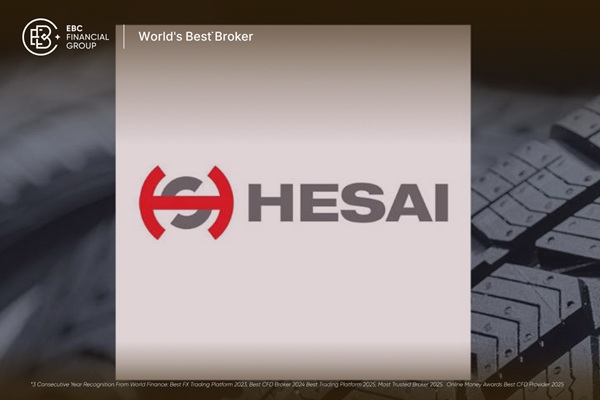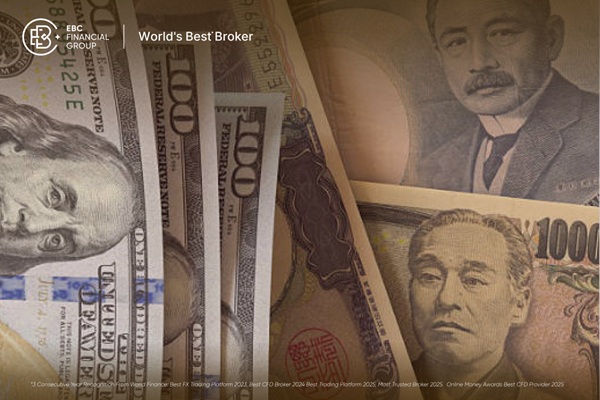The iShares MSCI China ETF (ticker MCHI) offers investors a broad gateway to China's listed equity market. With net assets of approximately US $8.16 billion as of 7 November 2025. the fund represents one of the more liquid ways for international investors to gain exposure to Chinese large‑ and mid‑cap stocks.
As China's economy continues to evolve and face both opportunities and headwinds, the MCHI ETF provides a meaningful tool for those looking to access Chinese equities in a packaged format. This article will explore its structure, investment rationale, risks, performance drivers, positioning relative to peers, outlook scenarios and practical trading considerations.
Fund Profile and Key Characteristics

The MCHI ETF is managed by BlackRock under the iShares brand, and was launched on 29 March 2011. It tracks the MSCI China Index, which aims to represent the performance of China‑based large‑ and mid‑cap companies available to international investors.
Here are some of the main features:
| Metric |
Value / Detail |
| Expense Ratio |
0.59 % per annum. |
| Total Assets Under Management (AUM) |
Approx. US $8.16 billion as of 7 Nov 2025. |
| Number of Holdings |
Around 555 holdings as of early November 2025. |
| Key Holdings |
For example Tencent Holdings (~16‑18 %), Alibaba Group (~8‑12 %) among the largest weights. |
Sector wise and geographic exposures are broadly diversified across China's listed large/mid‑cap space, although top holdings can dominate weighting.
The fund's large asset base and broad diversified profile make it a useful vehicle for gaining China exposure. Nonetheless one must attend to cost, liquidity, tracking error and country/sector risk when utilising it.
Investment Rationale: Why Consider MCHI?
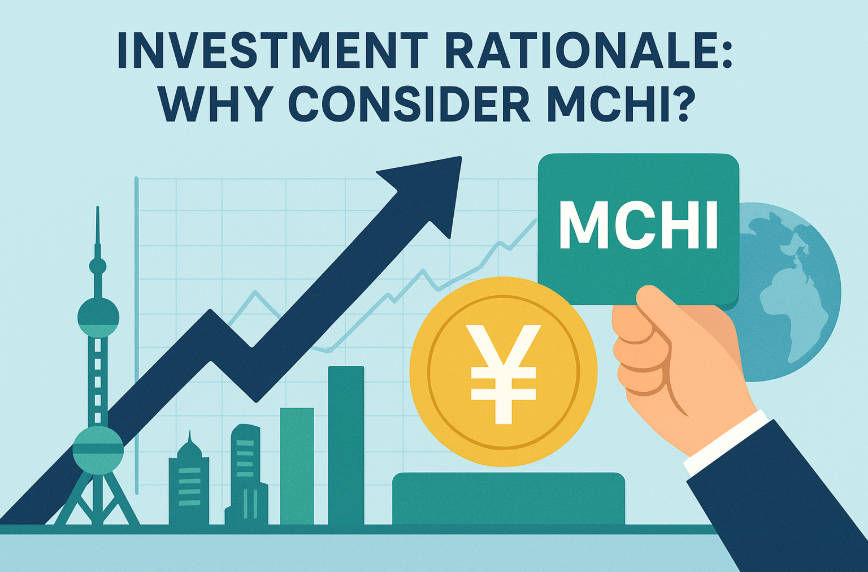
There are several reasons why an investor might choose the MCHI ETF:
Growth opportunity:
China remains the world's second largest economy and hosts many large companies participating in technological innovation, internet & consumer growth, and domestic market expansion.
Diversification:
By including Chinese equities via an ETF like MCHI, a portfolio can obtain country‑specific exposure which may have low correlation with developed markets.
Tactical or strategic tool:
Investors may use MCHI for a long‑term strategic tilt toward China or as a tactical way to access Chinese equities when conditions are favourable.
Liquidity and structure benefits:
As an ETF listed on the NASDAQ, MCHI provides intraday tradability, transparency on holdings, and relatively modest cost (by China ETF standards) compared with niche alternatives.
These attributes make it potentially attractive for investors willing to accept higher volatility in exchange for exposure to Chinese equities.
Risk Factors and Challenges
Investing via MCHI involves several risks that deserve careful consideration:
Macro‑economic risks:
China's growth has slowed in recent years compared with its historic pace. Risks such as property sector stress, demographic headwinds and weaker domestic demand can impact companies in the index.
Regulatory and geopolitical risks:
Chinese firms are subject to domestic regulation and to external geopolitical pressures (for example US‑China relations). A shock in regulation or international trade relations could depress valuations.
Concentration risk:
Although the ETF has hundreds of holdings, the top names (such as Tencent, Alibaba) represent a substantial portion of assets. That concentration increases idiosyncratic risk.
Currency and liquidity risk:
Investors in MCHI carry exposure to the renminbi exchange rate (indirectly) and may face liquidity issues in extreme market stress.
Volatility and performance drawdown risk:
As the historical return table shows, China equities (and thus MCHI) can suffer large drawdowns, as in 2021‑22.
Understanding these risks helps in setting realistic expectations and in managing portfolio exposure.
Comparative Positioning: MCHI vs Other China‑Focused Funds
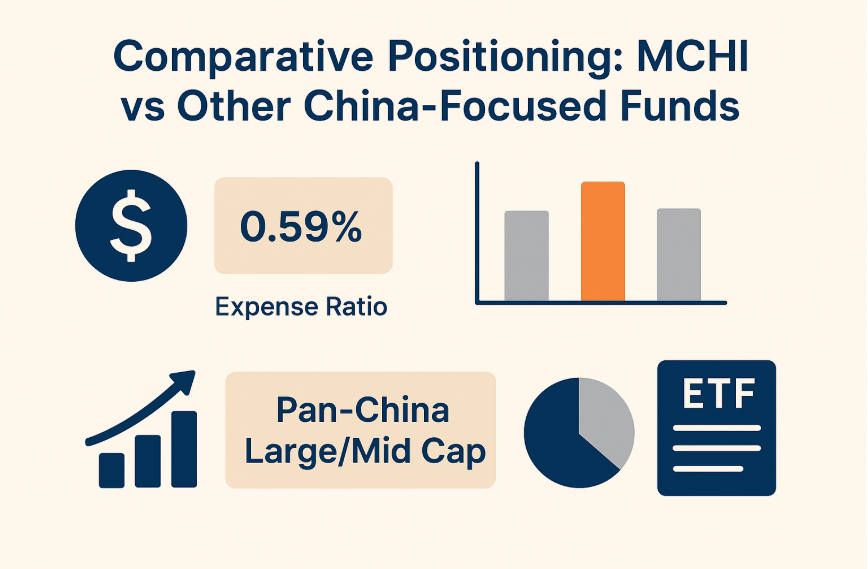
When evaluating MCHI, investors should compare it with alternative China‑oriented ETFs. From the data:
MCHI has an expense ratio of 0.59 %, which is competitive though not the lowest in the China ETF space.
In terms of AUM, MCHI (~US $8 billion) is sizeable, but there are China ETFs with larger or smaller asset bases depending on niche markets (for example China A‑shares, internet‑only).
Liquidity and tradability: MCHI's listing on NASDAQ gives it decent liquidity, but for very large trades or institutional scale one might compare ADV (average daily volume) and spread.
Exposure profile: Because MCHI tracks a broad index, it provides a pan‑China large/mid cap exposure. Some competitors may focus more narrowly on China tech or on China A‑shares or have different weighting schemes.
A rational investor should ask: what is my objective — broad China equity exposure, tactical bet on tech, or niche growth segment? Then choose the ETF accordingly. MCHI is a robust generalist option.
Recent Developments And Drivers for MCHI Performance
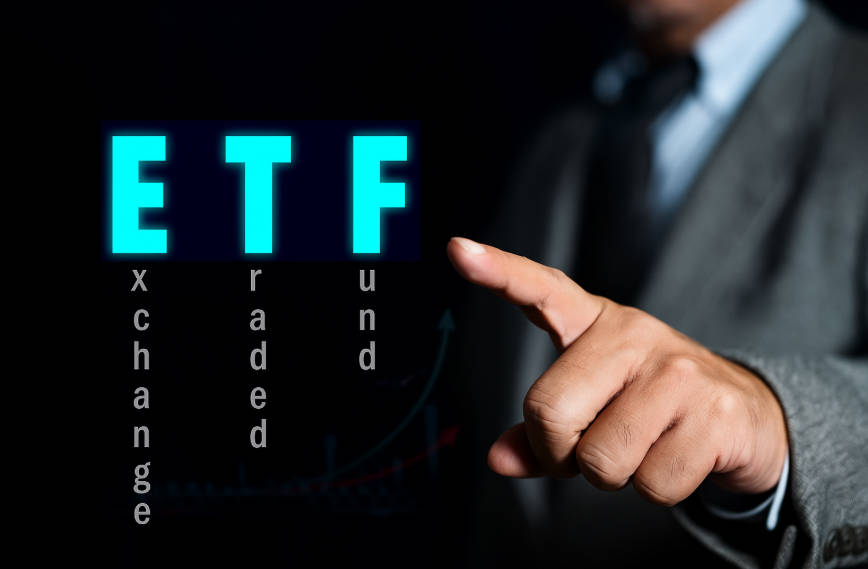
In 2025. the Chinese equity market has seen a meaningful rebound after prior weak years. According to YCharts, MCHI's AUM reached about US $8.159 billion as of 7 November 2025.
Performance data show that MCHI's 1‑year return is about +18.06 % NAV basis per its fact sheet as of the fund's last update.
Key catalysts driving MCHI performance include:
Improved corporate earnings in China, particularly in tech and internet sectors.
Government stimulus expectations and monetary easing signals in China.
Re‑rating of China equities after extended under‑performance relative to global peers.
Easing regulatory concerns in selected sectors and investor flows returning.
At the same time, risk factors remain live and include renewed regulatory intervention, macro slowdown, global risk‑off sentiment or trade tensions. A recent article noted: "China's stock market is experiencing a strong rally in 2025 … MCHI has surged nearly 40 % year‑to‑date."
Technical And Valuation Considerations
From a valuation perspective, MCHI's holdings show price‑to‑book (P/B) ratio around 1.86 according to the fund fact sheet. While price‑to-earnings (P/E) for the portfolio is around mid‑teens (eg ~15.34) based on holdings data.
These valuations suggest that while the fund is not obviously cheap relative to its own history, it may still offer value compared to developed market equities, especially given China's growth potential.
Technical traders may review chart patterns, support and resistance levels on the ETF itself, and monitor whether momentum is accelerating or plateauing.
Portfolio Implementation: How To Use MCHI
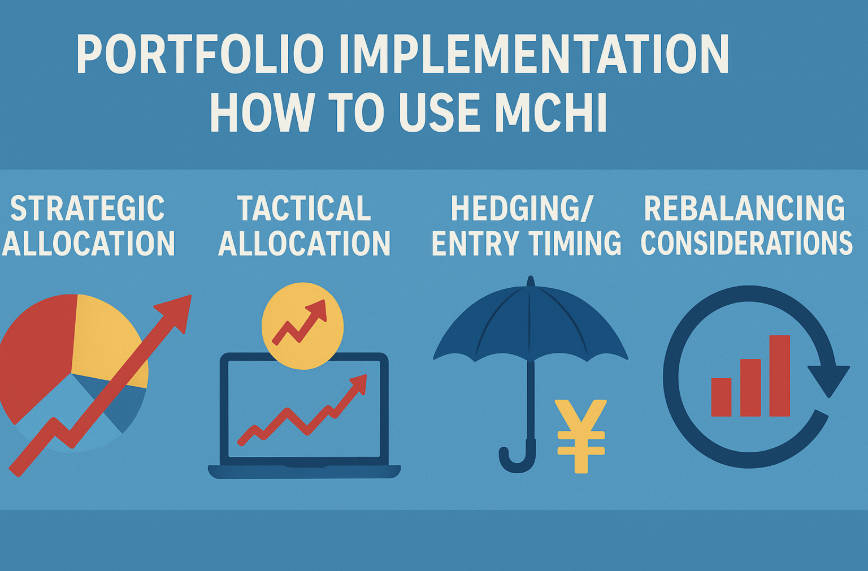
Here are practical ways investors might use MCHI:
Strategic allocation:
As part of a global equity portfolio, an allocation to MCHI provides Chinese equity exposure. This could range from a modest tilt (eg 5‑10 % of equities) to a larger structural weighting depending on conviction.
Tactical allocation:
Investors expecting a reflation or reopening in China may hold MCHI as a tactical overweight opportunity, with a view of capturing upside.
Hedging/entry timing:
Because exposure to China is higher risk, it is prudent to consider cost of hedging currency exposure, consider stop‑loss or position limits, and monitor flows or changes in regulation.
Rebalancing considerations:
Given MCHI's performance can be volatile, periodic rebalancing may be necessary to maintain desired exposure or to lock in gains.
Before investing, check the fund's bid‑ask spread, AUM, average daily volume, holdings and expense ratio to ensure suitability.
Outlook And Scenarios: Future Paths For MCHI
Three plausible scenarios for MCHI's future are:
1. Base Case
Moderate Chinese growth continues, earnings improve, and MCHI achieves mid‑teens annualised returns. China remains a structural growth story, regulatory risk does not flare.
2. Bull Case
Accelerated tech adoption, favourable government policy, strong global demand for China's exports lead to outsized returns. MCHI rises 20‑30 %+ annually for a period.
3. Bear Case
China growth falters, regulatory shocks emerge, or global risk‑off flows hit China first. MCHI experiences decline of 10‑20 % or more in a year.
Key signals to watch include Chinese GDP and export data, major policy announcements from Beijing, earnings surprises among top holdings, and fund flow trends into China equities.
Frequently Asked Questions
Q1. What index does MCHI track?
A1. MCHI tracks the MSCI China Index, which represents large and mid‑cap companies in China that are accessible to international investors.
Q2. What is the expense ratio of MCHI?
A2. The fund charges an expense ratio of 0.59 % per annum.
Q3. What are the top holdings of MCHI?
A3. Among its top holdings are companies such as Tencent Holdings and Alibaba Group, which together account for a significant portion of the fund's weight.
Q4. What are the main risks to investing in MCHI?
A4. Key risks include Chinese macro slowdown, regulatory interventions, market concentration in top holdings, currency risk and global risk‑off events.
Q5. How has MCHI performed recently?
A5. As of the latest available fact sheet, the 1‑year return on the fund's NAV was approximately +18.06 %.
Q6. Is MCHI suitable for long‑term or short‑term investors?
A6. It can be suitable for both, depending on the investor's objective. For long‑term exposure to China equities it is viable; for short‑term tactical exposure the higher volatility means risk must be managed actively.
Q7. What yield does MCHI pay?
A7. The fund's trailing 12‑month distribution yield was approximately 2.24 % as of 31 October 2025.
Q8. How does one access MCHI and what should one check before investing?
A8. MCHI trades on the NASDAQ under ticker MCHI. Investors should check its net assets, average daily volume, bid‑ask spread, holdings and expense ratio before entering.
Conclusion
The MCHI ETF provides investors with a broad and relatively cost‑efficient way to gain exposure to China's equity market. Its advantages include diversification into China's large‑cap growth companies, access to a sizable and liquid vehicle, and the capacity to use it for both strategic and tactical allocations. At the same time, investors must recognise and manage the distinctive risks attached to China equities including regulatory uncertainty, macro variability and market concentration.
Disclaimer: This material is for general information purposes only and is not intended as (and should not be considered to be) financial, investment or other advice on which reliance should be placed. No opinion given in the material constitutes a recommendation by EBC or the author that any particular investment, security, transaction or investment strategy is suitable for any specific person.

















